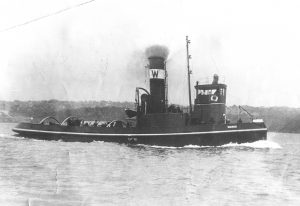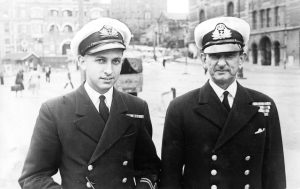- Author
- Editorial Staff
- Subjects
- Biographies and personal histories
- Tags
-
- RAN Ships
- HMAS Waree
- Publication
- June 2016 edition of the Naval Historical Review (all rights reserved)
Cyril Maurice (Bill) Boas was born on 10 December 1899 at Nilgiri Hills, Tamil Nadu, in southern India. He was the first of four children born to Captain John and Winifred Boas. Captain Boas was from a mercantile family working out of India and his family resided there.
Like his father Cyril was apprenticed to the sea and after gaining a master’s (foreign going) certificate settled to a career as a China coast pilot. In 1926 he married Minnie Violet Marie (Minks) Davis and settled in Hong Kong, where they brought up two daughters. In November 1941 with the Japanese invasion impending, the family was evacuated to Australia. Cyril found employment as a civilian pilot working out of Darwin and made a number of voyages taking merchant ships with defence supplies to Timor.
Bill Boas was appointed as a Probationary Temporary Lieutenant RANR (S) on 14 July 1942 and shortly afterwards to HMAS Rushcutter (additional) for the examination vessel HMAS Adele. The steam-yacht Adele previously served as the Naval College tender and was then known as HMAS Franklin. In Adele he is listed as a junior officer below her captain LEUT John Kennedy, RANR (S) and the executive officer. He was in this ship in a storm on the night of 7 May 1943 when she struck the breakwater at her home port of Port Kembla; there was no loss of life but the ship sank, becoming a constructive loss. Bill was not implicated in the loss of this ship.
In June 1943 he was posted to Northern Australia and New Guinea on harbour defence duties. While in Darwin on 28 March 1946 he was given command of the coal burning harbour tug HMAS Waree. There are a number of records of the Diesel Tug (DT) 931, which later became HMAS Emu, being commissioned in Sydney on 30 July 1946 under the command of LEUT Boas. However his service record notes this posting was cancelled.

On 11 September 1946 a strange convoy left Darwin, comprising the boom defence vessel HMAS Kangaroo towing the motor launch ML 702, with the heavily laden tug HMAS Waree covered by a deck cargo of 31 tons of coal. Under the overall command of Kangaroo the convoy proceeded slowly via Thursday Island and then down the east coast as far as Townsville where the convoy dispersed. Many stops were necessary for Waree to top up with coal and clean her boiler tubes – desirable after 48 hours steaming. This was to be a one way trip for Waree with a scratch crew of inexperienced sailors as she was due to be sold out of service after arrival in Sydney.
Waree next sailed independently to Brisbane. After replenishment and re-coaling, this time with 20 tons of deck cargo, she sailed on 15 October for the final leg to Sydney. While the weather forecasts were for strong winds this was not considered detrimental to her progress. As the winds strengthened and seas increased Waree unsuccessfully sought shelter on the coast, then when she started taking on water and the bilge pump failed her captain decided to make for the nearest land at the entrance to the Clarence River. During this ordeal Boas signalled for assistance and the frigate HMAS Macquarie, which was towing a lighter down the east coast and had been sheltering off Cape Byron, was diverted. Macquarie arrived too late to be of assistance.
On 17 October Waree grounded while trying to cross the bar and she stranded some distance off-shore. The captain ordered ‘abandon ship’, then he and his crew of 20 men wearing life jackets swam ashore through dangerous surf. While the executive officer was injured being dashed on rocks there was no loss of life, however the ship could not be salvaged.
For some years Waree’s upperworks were clearly visible above high water but when the breakwater was later extended this was built very close to the wreck site. At low water the outline of a wreck remains visible but all that now remain are some relics which have been preserved at the nearby Yamba Maritime Museum; these include her brass binnacle, the ship’s bell and part of her wheel.
LEUT Boas was subsequently court martialled for hazarding and stranding his ship. In all, four charges were preferred and he was found guilty of two. The court ordered what some considered a lenient sentence, a reprimand. They may have taken into consideration mitigating factors, such as an apparent lack of attention to the ship’s readiness for sea, on behalf of the Naval Officers in Charge at Darwin and Brisbane. There may also have been an apparent lack of coordination concerning fleet assets on the Australian Station. Finally no lives were lost.
Recollections by Marsden Hordern

LEUT Cyril Maurice Boas was tried by court-martialled for the loss of his ship and I was appointed Provost Marshall giving me responsibility for his safe custody until he was delivered into the jurisdiction of the court. Accordingly I was continually in his presence for days before and during the trial which took place on 22 November 1946. My duties ceased when he was found guilty and sentenced to be reprimanded for hazarding and stranding HMAS Waree.
His defending officer presented a rather inept case, whereas the prosecuting officer was more aggressive. Bill Boas was a likeable merchant service officer who had fought at sea during WWI (he appears to have five WWI medal ribbons). He became a Master Mariner and found employment as a pilot on the China Coast. Following the Japanese occupation of much of China he eventually found himself in Australia where he volunteered to join the RANR. While somewhat coarse in speech and expression he was regarded as a fine and experienced seaman who unfortunately treated those who he considered lacking in seafaring experience with distain. This could lead him into trouble with more senior officers.
When asked by the court if he had much experience of bars (meaning those at the entrance to estuaries) he replied ‘plenty along the Shanghai waterfront’. This type of flippancy, which does not appear in the court martial proceedings, prejudiced the court against him.
Boas was a heavy drinker who was forbidden alcohol before and during the trial at HMAS Penguin. This caused him severe depression and he begged me to get him a drink. On a number of occasions I arranged for a bottle of beer to be passed to him under the door of a cubicle in the officer’s heads, which he secreted in his jacket and took it to his cabin to drink. This was wrong of me but I judged Bill would have been unable to continue without some relief to his addiction.
The final Chapter
At the time of his court martial Boas was appointed (additional) to the fleet tug HMAS Sprightly. Subsequently he returned to Northern Australia as Boom Defence Officer Darwin; with demobilisation his appointment was terminated on 22 February 1949.
Contemporary information concerning the new tug Waree, which is managed by the Defence Maritime Services agency, states the original ship of this name was returned to her owners in 1946. Other documentation states the tug Emu was commissioned by LEUT Boas. As discussed in this paper both these statements appear to be incorrect.
There is scant information on Bill Boas after his naval service and life may have been difficult. In 1953 Bill and Minks divorced. She later became a teacher at Dulwich Hill High School. Bill died on Christmas Day 1957 just after his 58th birthday. He is buried at the Liverpool Cemetery in NSW. In June 1970, Minks died in her 67th year, with her funeral at the Eastern Suburbs Crematorium, Botany, NSW. And so ends our sad tale of Bill Boas and the Waree.




